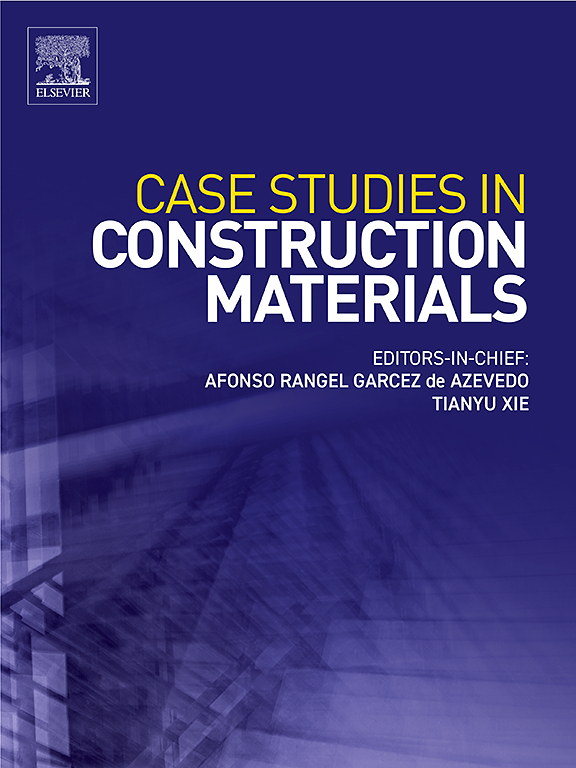Impact of pore geometry on mechanical properties and anti-clogging efficiency in porous drainage pavement structures
IF 6.6
2区 工程技术
Q1 CONSTRUCTION & BUILDING TECHNOLOGY
引用次数: 0
Abstract
Pervious concrete, a fundamental material in sponge city development, plays a vital role in mitigating surface runoff through enhanced rainwater infiltration. However, its long-term effectiveness is hindered by particle-induced pore blockage, which significantly reduces the permeability coefficient. Additionally, conventional pervious concrete often exhibits inadequate mechanical strength, limiting its capacity to regulate urban waterlogging and mitigate the heat island effect over time. This study integrated silica fume, polypropylene fibers, and a polycarboxylate superplasticizer into a self-compacting concrete matrix, utilizing 3D printing technology to fabricate porous drainage pavement structures with varied pore geometries. Finite element simulations using ANSYS were employed to evaluate the impact of five pore shapes on mechanical performance, complemented by experimental validation. The results reveal that structures with circular pores demonstrate superior performance, achieving a compressive strength of 50.71 MPa and a splitting tensile strength of 4.73 MPa. The close agreement between simulation and experimental results, with deviations within 4 %, underscores the reliability of the simulation model. Furthermore, circular pore structures exhibited the highest permeability coefficient (26.51 mm/s) and the lowest clogging mass fraction (3.23 %), confirming their enhanced hydraulic and anti-clogging capacities. Overall, the proposed porous drainage pavement system demonstrates significantly improved mechanical robustness and resistance to clogging compared to traditional pervious concrete. The hierarchical interception mechanism, comprising an upper wedge-shaped flow-guiding layer and a lower regular geometric seepage layer, effectively enhances the self-purification capability of the structure, offering a promising solution for sustainable urban drainage infrastructure.
孔隙几何形状对多孔排水路面结构力学性能及抗堵效果的影响
透水混凝土是海绵城市发展的基础材料,通过增强雨水入渗,在减少地表径流方面发挥着至关重要的作用。然而,颗粒引起的孔隙堵塞阻碍了其长期有效性,从而显著降低了渗透系数。此外,传统透水混凝土往往表现出不足的机械强度,限制了其调节城市内涝和缓解热岛效应的能力。本研究将硅灰、聚丙烯纤维和聚羧酸盐减水剂集成到自密实混凝土基体中,利用3D打印技术制造具有不同孔隙几何形状的多孔排水路面结构。利用ANSYS进行有限元模拟,评估了五种孔隙形态对力学性能的影响,并进行了实验验证。结果表明,圆形孔隙结构的抗压强度为50.71 MPa,劈裂抗拉强度为4.73 MPa。仿真结果与实验结果吻合较好,误差在4 %以内,说明了仿真模型的可靠性。此外,圆形孔隙结构具有最高的渗透系数(26.51 mm/s)和最低的堵塞质量分数(3.23 %),证实其具有较强的水力和抗堵塞能力。总体而言,与传统透水混凝土相比,所提出的多孔排水路面系统具有显著提高的机械坚固性和抗堵塞性。由上部楔形导流层和下部规则几何渗流层组成的分层截流机制,有效提高了结构的自净化能力,为可持续城市排水基础设施提供了一种有希望的解决方案。
本文章由计算机程序翻译,如有差异,请以英文原文为准。
求助全文
约1分钟内获得全文
求助全文
来源期刊

Case Studies in Construction Materials
Multiple-
CiteScore
7.60
自引率
19.40%
发文量
842
审稿时长
63 days
期刊介绍:
Case Studies in Construction Materials provides a forum for the rapid publication of short, structured Case Studies on construction materials. In addition, the journal also publishes related Short Communications, Full length research article and Comprehensive review papers (by invitation).
The journal will provide an essential compendium of case studies for practicing engineers, designers, researchers and other practitioners who are interested in all aspects construction materials. The journal will publish new and novel case studies, but will also provide a forum for the publication of high quality descriptions of classic construction material problems and solutions.
 求助内容:
求助内容: 应助结果提醒方式:
应助结果提醒方式:


